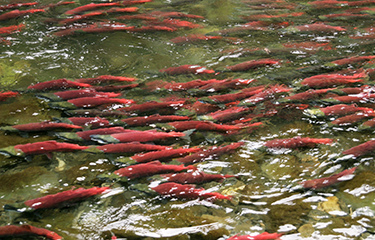A recent study that dove into more than 60 years of records from the Alaska Department Fish and Game found that salmon returning to Alaska’s rivers are on average smaller than they were in the past.
The study, headed up by biologists from the University of California Santa Cruz and the University of Alaska, Fairbanks, attributes declines in salmon size to "shifting age structures associated with climate and competition at sea."
The smaller fish are largely a result of salmon returning to their natal streams at a younger age, according to the report, although some salmon may be developing less body mass over the same amount of time.
“Across species, shifts in age structure explained 88 percent of interannual variation in mean size on average. In general, salmon are currently smaller than in the past because adults are returning to spawn at younger ages,” the report said.
Smaller salmon effect ecosystems and people – they produce fewer offspring, transport fewer nutrients up rivers, and cause losses in commercial fishing because of lower flesh-recovery rates. The study looked at Chinook, sockeye, Coho, and chum salmon, and found average sizes smaller in all four species of fish before 1990 compared to fish after 2010.
Chinook experienced the largest average size drop at 8 percent in body length. Researchers estimate that Chinook egg production dropped by 16 percent, nutrient transport was down 28 percent, and commercial value was down 21 percent. Chinook salmon also showed the most linear size decline, with an accelerated decline after 2000. Sockeye, chum, and coho salmon shared size fluctuations amongst themselves, with declines starting in the mid-1980s and recoveries in the early 1990s, followed by abrupt declines that started in 2000 and amplified after 2010.
“Both environmental change and increased competition at sea with highly abundant wild and hatchery salmon could result in body size declines through reductions in the availability or quality of food resource,” the report said.
A 2019 study by University of Washington researchers stated that salmon abundance in the North Pacific Ocean doubled between 1960 and 2010. That study found that while wild salmon numbers were higher, at least 40 percent of the salmon were hatchery fish released by surrounding nations.
And while climate change and competition are major contributors to declining salmon size, the study’s first author, Krista Oke, told The Cordova Times there are a complex set of factors at play.
“There’s not a single smoking gun. Small contributions from a lot of factors are adding up to drive these changes,” Oke said.
The report also pointed out that certain factors affected certain species more heavily. For example, abundant North Pacific pink salmon were found to bring down sockeye salmon size, while the North Pacific Gyre Oscillation resulted in smaller chum salmon but larger coho salmon.
Magnitude of declines varied largely throughout the state, with Chinook salmon down by 10 percent in Westward Alaska and the Artic-Yukon-Kuskokwim and down just 4 percent in Southeast Alaska, for example.
University of Washington biologist Daniel Schindler told SeafoodSource that sockeye in Bristol Bay, Alaska have not been getting smaller on average. However, research by Schindler and his colleagues in Bristol Bay indicates that climate change is altering sockeye life-cycles in the region.
Lakes and streams are warming up quicker in the spring, providing more food and speeding the growth rate of juvenile salmon. As a result, most sockeye salmon are leaving the freshwater after a year, where previously many fish in the same age class would stay for two years. Schindler said larger numbers of sockeye are then spending three years in the ocean instead of one or two, boosting overall weight averages.
Schindler added that Bristol Bay has seen some larger runs of smaller fish in recent seasons, and that hatchery pink salmon are thought to be a major factor pushing down growth rates of sockeye.
Photo courtesy of CLP Media/Shutterstock







